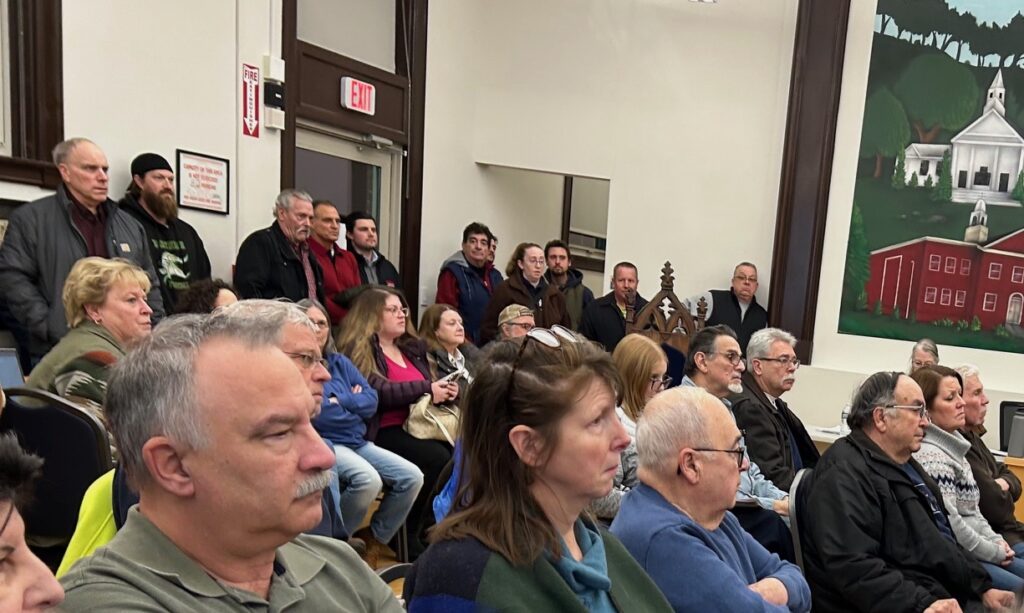
NORTH SMITHFIELD – Tensions ran high at times between residents and hired professionals looking to make the case for creation of a new, customized zoning district that would legitimize one business’s mining operations at a series of meetings held over the past two weeks.
At a public hearing on Tuesday, Feb. 18, Town Hall chambers were filled to capacity, with residents spilling into the hallway as they waited to give testimony and have questions answered about Pound Hill Realty’s request for a zoning amendment. Bodies were counted to ensure the crowd gathered did not exceed the room’s 82-person capacity.
The meeting was the third in recent weeks regarding a request by the business, known locally as Material Sand & Stone, to amend the town’s zoning ordinance to create a new “Industrial Special Management District 1 Overlay,” and to change the zoning of their 89-acre site on Pine Hill Road from Rural Estate Agricultural to the new designation, with corresponding amendments to North Smithfield’s zoning map.
“The reason that we’re here – the property has been in consistent litigation with the town since 1991 in effort to clarify the nature of its non-conforming use,” said Attorney William Landry of Blish & Cavenaugh, representing the business. “It’s resulted in no real progress toward that end. The court has directed the parties to go back to the town to pursue administrative remedies.”
Landry presented Material Sand’s proposed plan to create an overlay zone – where mining is permitted – as a compromise, and a way to create municipal transparency and oversight on a property “not effectively regulated by zoning,” due to what he described as a use that precedes the town’s moratorium on the activity.
“The EPA regulates this property. The Rhode Island Department of Environmental Management regulates this property. The Bureau of Mining Safety regulates this property. OSHA regulates this property,” said Landry. “Given its proximity to landfills and superfund sites, it’s probably one of the most heavily regulated pieces of property in the entire state.”
“The bad part is that for 70 years the activity has been pretty much removed from the view of the local regulatory body,” he said.
The attorney would go on to speak for 40 minutes on Monday, repeating much of what was said at a workshop with the Town Council the previous week as well as at a meeting on Thursday, Feb. 13 with the Planning Board, where Material Sand is hoping their proposed solution will be deemed consistent with the town’s comprehensive plan.
But Landry said little about the issue at the heart of the dispute between the business and the town that started the litigation more than 30 years ago. That was summed up – at least from his perspective – late in the meeting by resident Richard Grubb.
“They purchased one of the properties well after the ordinance went into effect that stated a moratorium on mining. Then they applied for a permit to scrape 450,000-cubic-yards of material off of that new property, which is not zoned for industrial,” said Grubb. “Then they were denied that permit. So what did they do? They merrily went about their business anyway. They decided they would mine the property without any permits, without any authorization, and when they were told ‘cease and desist,’ they sued the town.”

On Monday, much of the testimony focused on the details of Material Sand’s current operations, with hired experts in water/aquifer issues and blasting on hand to dispute the idea that the business could cause environmental harm. The property is adjacent to a superfund site known as Western Sand & Gravel, with the Wilson Resource Recovery site also nearby.
Owned by the Pezza family, the business has been mining in the area since the 1950s, long before town officials passed an ordinance that aimed to phase out earth extraction in the late 1970s – with language that exempted existing businesses operating on land acquired before passage.
But in 1991, then Town Building Inspector Bob Benoit noted that Material Sand’s “grandfathered” rights to mine the property did not extend to a second lot the business purchased in 1987, ultimately leading the business to file litigation appealing the action. Attempts by town officials to monitor quarry operations seem to have completely ceased following a legal decision ordering a stay on the matter in 2006.
Resident Jason Richer has been a main force drawing attention over the past several years to the town’s lack of regulation of quarry activities, questioning the company’s permitting, road use, water discharges, silica from blasting and more.
NRI NOW spoke with Richer in 2022, publishing an article on the unusual legal situation, and his difficulty getting answers regarding the business’s permit. At the time, the company declined to comment, instead renewing litigation just months later that aimed to permanently block the town from enforcing its zoning, earth removal and road use ordinances after nearly two decades of inaction.
But this time, the judge ruled in the town’s favor, ordering the business to follow local processes.
The company has since addressed one element of zoning, securing an agreement for the use of town roadways last March.
And last month, Material Sand submitted the unique proposal now before the council for creation of a new overlay zone.
Robert Ferrari of Northeast Water Solutions made a presentation on Monday regarding the business’s extensive efforts to contain runoff from the property via berms, infiltration ponds and the use of existing elevation to control water flow and prevent interference with remediation efforts on the neighboring superfund property.
“The last thing they want is that contaminant plume to go anywhere other than where it’s supposed to,” said Ferrari.

Ferrari disputed previous claims by Richer that quarry operations have breached an aquifer beneath the property, and also addressed recent improvements planned with RIDEM. The area, he said, got 44 inches of rain between December 2023 and May 2024, leading to observations of runoff from the property.
“There were a couple instances where we had some degradation from the top of the berm on one or two of the ponds,” said Ferrari. “We don’t know exactly how much water was discharged but we believe it was not much. As an outcome of that, the owners, on their own volition, doubled the thickness of the berm.”
Questioned on the presentation later, Ferrari repeated the assertion that the changes are voluntary.
“DEM is not forcing the site to do anything,” he said. “We agreed that we want to improve things.”
“It is physically impossible for water from the site to overflow onto the landfill site,” Ferrari added.
Landry said that Material Sand’s operations have “a very satisfactory record in every respect,” with regulators. The attorney has said that the business will provide councilors records of regulation activities from the past year, and that similar reports will be provided to the town on an annual basis if the zone change is passed.
But with no such records on hand this week, councilors had no way to evaluate or verify such assertions.
Opponents, however, did come armed with some records challenging the statement, reading from an EPA report as well as a recent order from RIDEM ordering improvements on the site to be completed by July.
Councilor Rebecca DeCristofaro recused herself from council deliberations, speaking as a resident about elevation levels in the quarry.
The EPA inspector noted “the northeastern side is much deeper and well below the known groundwater elevation for the region,” she said, quoting a report. “Is that accurate?”
“It’s not an accurate statement,” said Ferrari. “The groundwater table varies across this region.”
“It’s unfortunate that we can’t trust the EPA,” DeCristofaro responded.
“It’s not that you can’t trust the EPA,” said Ferrari. “They made commentary based upon a certain snapshot of information.”
It was one of several tense moments at the meeting. Council President Kimberly Alves was among several in attendance to question statements made by Landry at the previous workshop held on Monday, Feb 10.
“Last week we were told that water was being trucked in because it was contaminated,” said Alves. “Now you’re saying there’s no contaminated water on this property.”
Ferrari said there is no contamination on the site, and Landry walked back his previous statements, made as part of an effort to make the case to councilors that the area was not appropriate for residential use.
“Something associated with the surrounding superfund sites apparently at one point made people concerned about the quality of well water,” Landry said.
Resident Liane Jalette later quoted Landry from the February 10 meeting stating, “Yeah, the aquifer is contaminated. It is not a safe place to drill residential drinking water wells.”
“I’m just looking for clarification because that is what was stated,” Jalette said.
“That was not a completely accurate statement,” said Landry. “It is what I understood to be the case last Monday.”
Jalette also later read statements from a recent RIDEM report.
“The DEM inspection revealed significant environmental impact as a result of the breaching of the berming around the Pine Hill Quarry site in two locations,” she read. “A letter of non-compliance was sent to the property owner to address violations of no discharge certification.”
- Several residents said that they believe the business’s activity has affected their wells, both Monday and at the previous Planning Board meeting.
Old Oxford Road resident Robert Belhumeur told planners he hired someone to fix his well because it was producing sand.
“He couldn’t get in there because half the superstructure on top – the earth and the stone on top – had moved and collapsed the hole,” Belhumeur said. “I had to put a new well in.”
More recently, Belhumeur said he’s noticed cracks in his walls.
“The lawyer made a very nice presentation,” he said. “He did a great job. I can’t fight him. All I can do is tell you guys.”

“I’ve had issues with what I believe was the blasting at the site,” said resident Darlene Machado on Monday. “It must kick up the sand in the system because it actually pierced the bladder in the holding tank in the well.”
Abutter Lucien Lamoureux said the last year, the business put in two reverse osmosis tanks to address his poor water quality.
“Every time they blasted, it was brown for a day or two,” said Lamoureux. “You couldn’t do washing.”
Those affected questioned the possibility of regular well testing, or if they might be able to connect to a water tank that currently serves homes in neighboring Burrillville.With time running short, industrial seismologist Richard Groll did not get a chance to present the business’s side of the case on Monday.
Two residents did speak in favor of the business, including 42-year Pine Hill Road resident Robert Boisclair.
“As far as Material Sand, I’ve never had a problem with that company,” said Boisclair. “I’m right at the gate.”
Resident Andrew Croshaw, who works as a project manager for Narraganset Improvement, noted he was not an abutter, “but a concerned citizen for businesses in this community and what they have to go through to stay in this community and operate.”
“Things are a little tough right now for these folks,” Croshaw said, noting a barrier installed by the business is preventing migration of contaminated groundwater. “It seems like the operation is a beneficial thing by creating that hydraulic barrier. I’m in support of Material Sand.”
After more than three hours, Groll had yet to present his case and the bulk of the crowd remained.
The hearing was continued to the council’s meeting scheduled for Monday, March 3, with the location still to be determined.
“We’re going to try to make it at the middle school because of the crowd,” said Alves.
At their meeting, planners presented several specific suggestions, with Landry noting concerns could be worked into stipulation for approval. That board also continued deliberations, with more discussion set for their next regular meeting on Thursday, March 13.
Full videos from the meetings are available here, here and here.
Editor’s note: An original version of the story identified one of the speakers as Robert Auclair. It has been corrected to Boisclair above.








So how is the Horse Farm Pezza promised would replace the sand & gravel operation when first starting coming along?
There was reference to a well having brown water. This is a natural occurrence. My parents had a well that produced red water, too high iron content for example, and no where near the quarry, was a very deep well. Washing laundry could not occur.
And myself living for 42 yrs near a military base, with bombing practices much farther away than the 50 foot planned buffer….THERE ARE indeed homes suffering damage, experiencing cracked walls, cracked foundations, cracked chimneys, cracked windows, and cracked wells and all this across a roadway only, farther than what the quarry is to these properties. And to add, that while wells are imbedded in the ground, and can withstand much disturbance, blasting so close can and will, affect adjoining properties over time. This company cannot say their blasting will not harm neighbors.
I would start taking videos, pics, have inspections of my well and property, document all prior to any of this continuing. Proof. Seems the rep also stated the town could not say no to the plan, as so many agencies have oversight over the company operation, and of past history/allowances……disturbing to have heard him say that as I watched the meeting.
Seems their reps like to tell you good things, what you would foremost like to hear, but common sense on earth disturbances, air disturbances, investigation of what others in similar situations have endured, indicate the full truth will eventually come.
Sadly you can buy a home today, invest so much, think you can rest in peace, and all over changes are made and not for the better. Worry sets in, anxiety. Expenses. Big business.
Thank you for covering this issue Sandy. One small edit the requested quantity to be excavated was 450,000 cubic yards. I did not go back and look at the video but it’s very possible I stated the wrong number while speaking.
Thanks Richard. It has been corrected above.